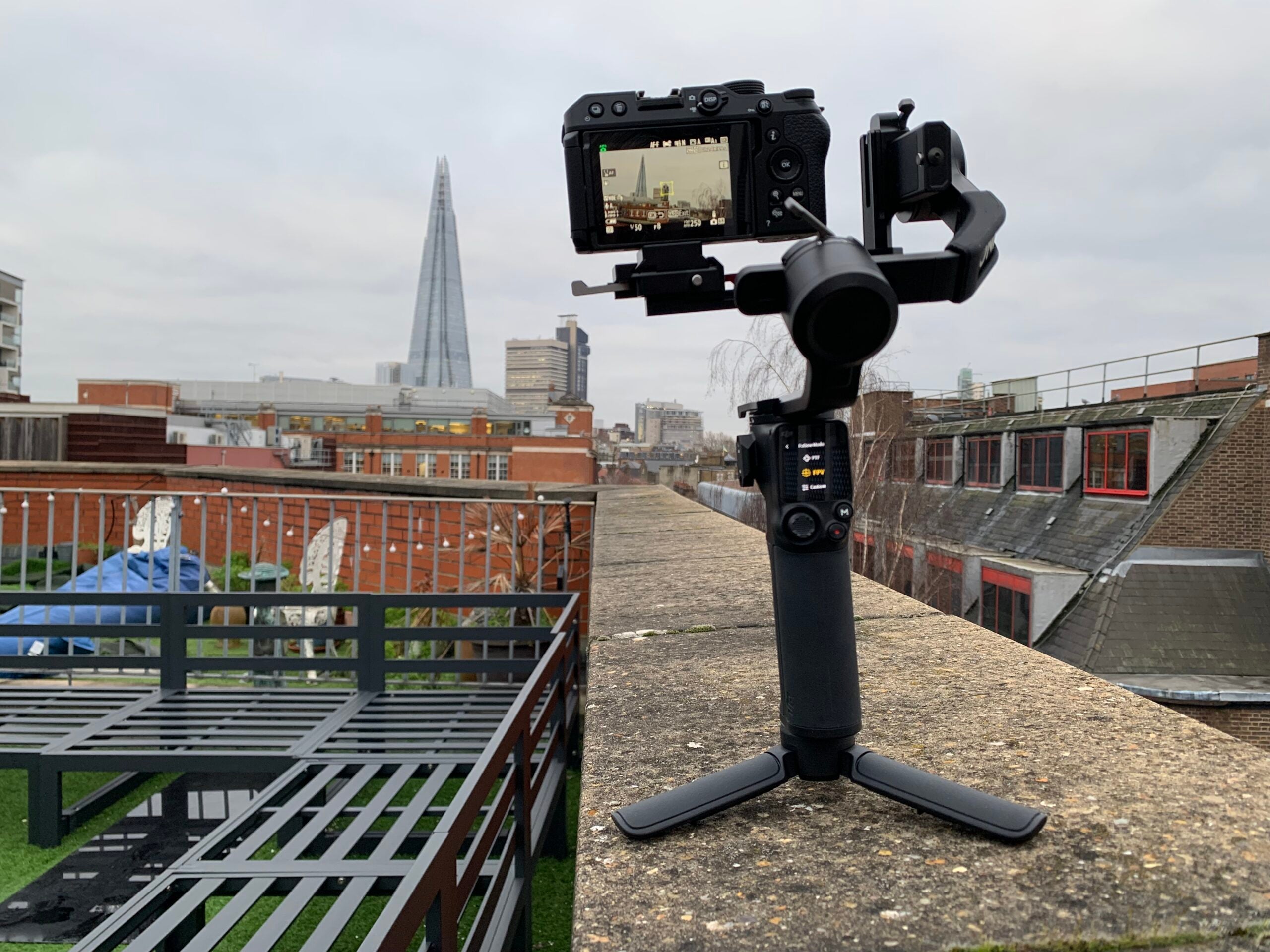Verdict
The DJI RS 3 Mini is a powerful gimbal for stabilising small mirrorless cameras. The battery life is a bit disappointing, but there are plenty of features to play around with and it’s more compact and affordable than the other gimbals in its series.
Pros
- Video is smooth and stable
- More compact and lightweight than other gimbals
- Touchscreen makes it easy to move between different modes and speeds
Cons
- Shorter battery life than expected
- Not all shortcuts are compatible with all cameras
Availability
- UKRRP: £339
- USARRP: $369
-
Small, lightweight designThe DJI RS 3 Mini weighs 795g and measures 180 × 159 × 296mm unfolded -
Designed for mirrorless camerasCan support cameras and lens of up to 2kg -
360-degree rotationWith the pan axis -
DJI Ronin appWith additional features like panorama and timelapse
Introduction
If you’re in need of a new camera stabiliser but baulk at the idea of lugging around a large gimbal, the DJI RS 3 Mini could be right up your alley.
The RS 3 Mini marks the third instalment in DJI’s RS 3 line, sitting just below the RS 3 and the RS 3 Pro, both physically and in terms of its specs.
The gimbal is part of DJI’s goal to bring professional-grade tech to content creators and can be paired with a wide array of mirrorless cameras.
Keep reading to find out more about DJI’s latest (and smallest) RS gimbal.
Design
- Setting up and balancing the gimbal is difficult the first time
- There’s a small touchscreen, along with some physical controls
- The gimbal is small and lightweight for a mirrorless camera gimbal but it’s still quite heavy
The DJI RS 3 Mini comes with several items in the box which need to be assembled before you can get started. This includes the tripod extension, the mounting plate, a screw to attach the plate and the gimbal itself.
If you’re familiar with building Ikea furniture, you should be able to figure out what goes where by following the wordless diagrams in the manual.
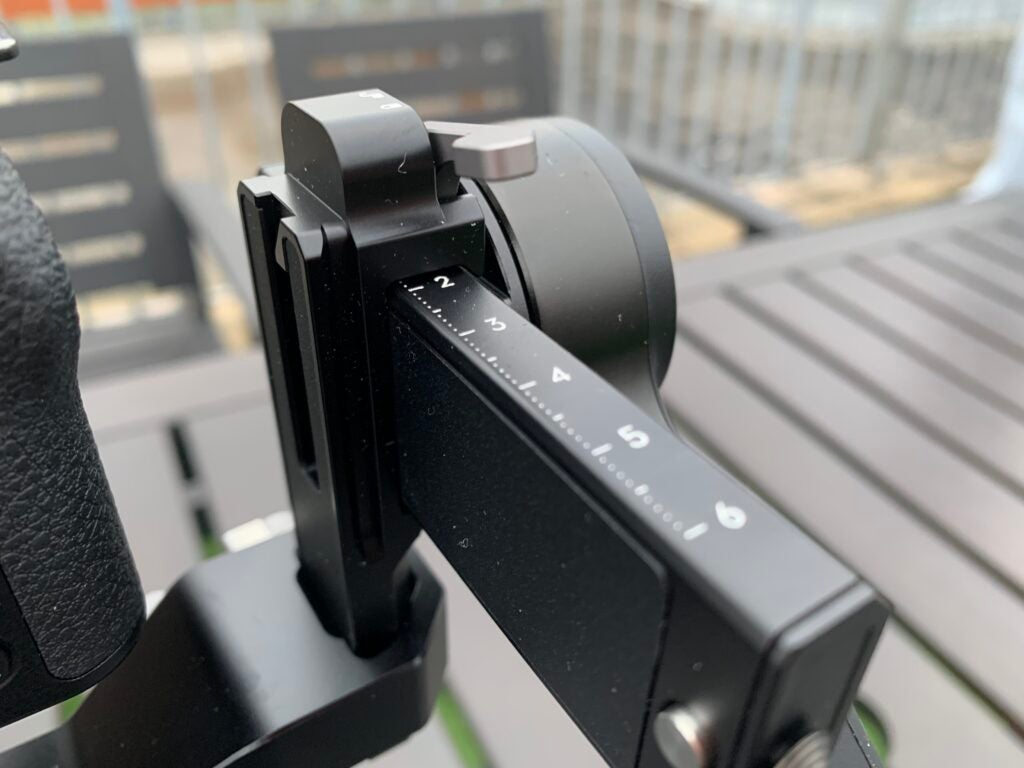
Once that’s done, the next step is balancing the gimbal. This is the part I found the most difficult the first time I mounted a camera, as there are several locks and levers that need to be pushed in a specific order to balance it correctly.
I do think this is something that likely gets easier with practice, as DJI requires its users to rebalance the gimbal every time they attach a new camera. The company also walks you through the process on its DJI Tutorials YouTube channel, so you can always head over there if you forget which lever corresponds to which axis.
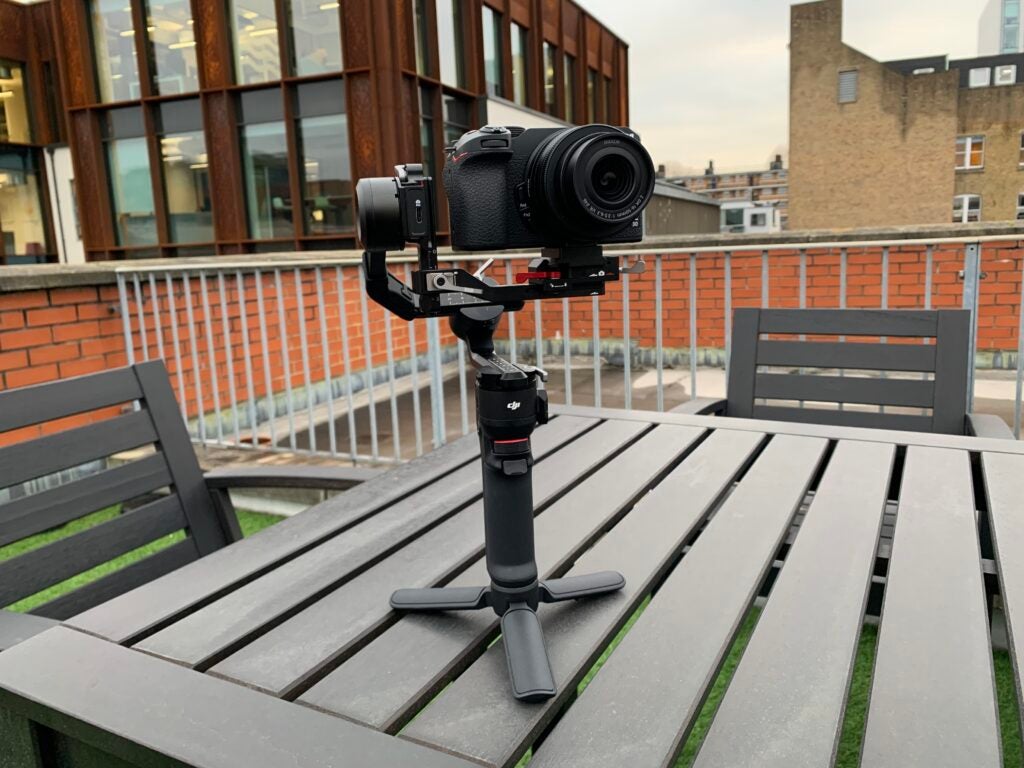
The RS 3 Mini itself has a simple black design with grey and red levers and a rubberised grip where the rechargeable battery lives.
Most of the controls can be found on the 1.4-inch colour touchscreen positioned above the grip, but there’s also a small array of physical buttons on the gimbal. These include a power button, a record button and an M button, as well as a trigger and a dial on the other side of the grip.
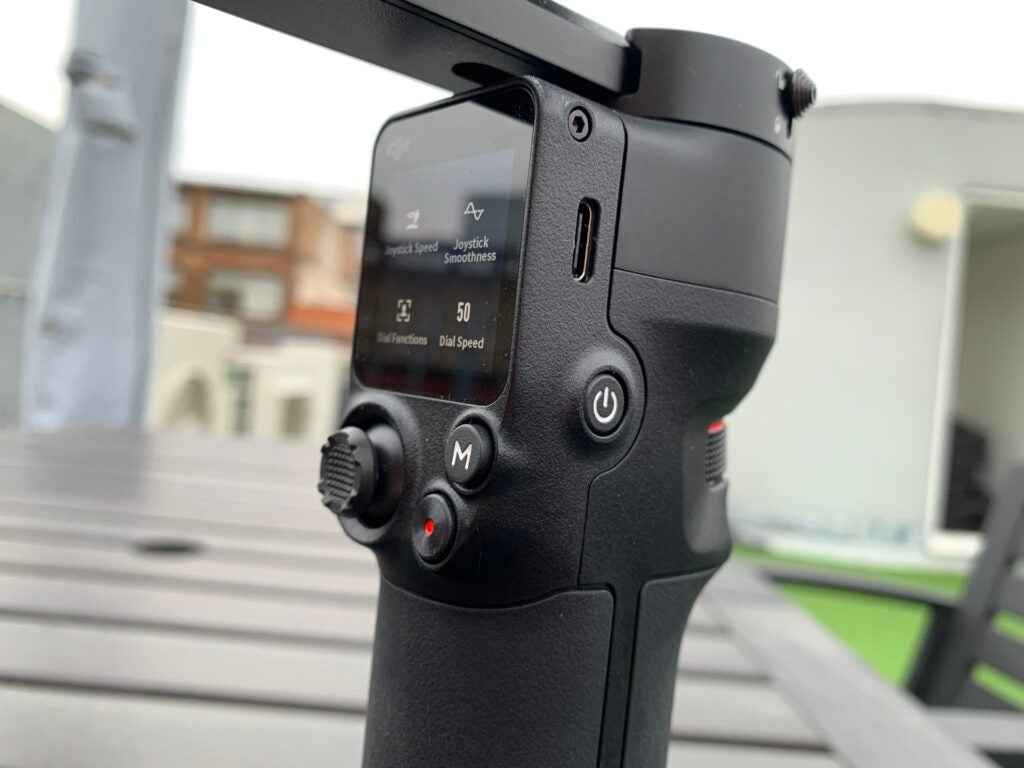
The gimbal also comes with a USB-C port for charging and a NATO port for attaching additional DJI accessories.
From its name, you might assume the RS 3 Mini would be small and lightweight – and it is compared to the other gimbals in its series. The Mini measures 180 × 159 × 296mm unfolded and weighs 795g. For comparison, the regular RS 3 measures 364 × 187 × 170mm and weighs 1.3kg and the RS 3 Pro is even bigger at 415 × 218 × 195mm and 1.5kg.
Despite its more compact size, the RS 3 Mini can handle up to 2kg of camera weight and has the added benefit of easily fitting in a tote bag or small backpack to take on the go.
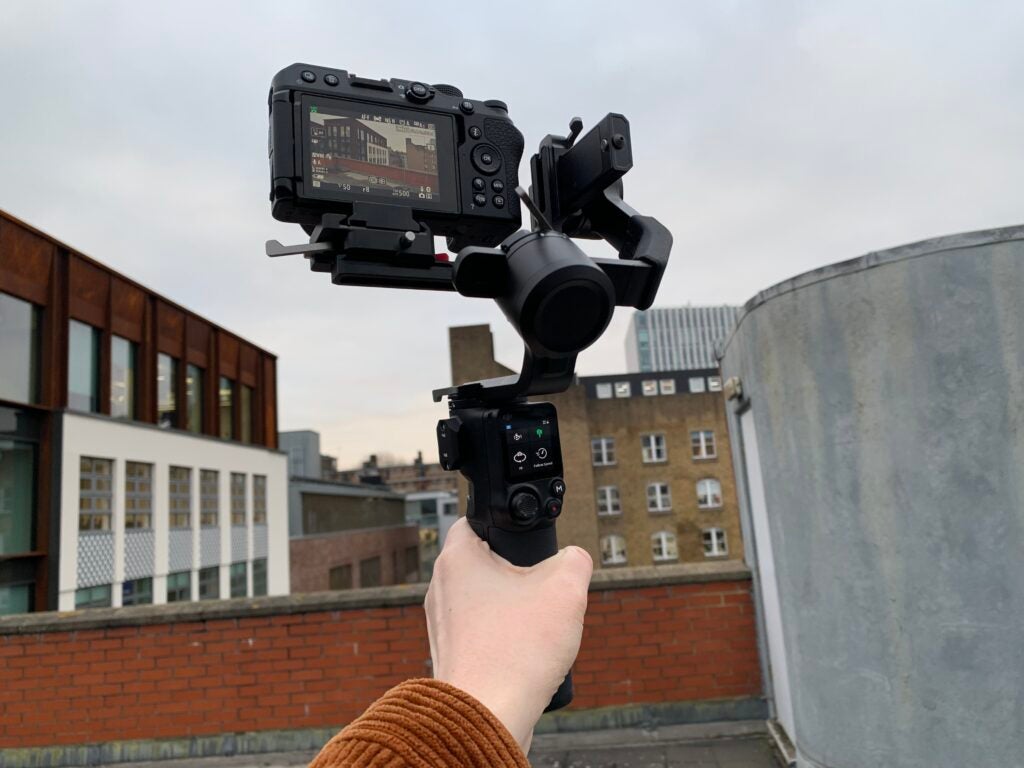
While not nearly as heavy as the other gimbals in the series, the Mini isn’t exactly feather-light either. It’s a good job the device is designed to keep cameras stable, as otherwise, I think I would have captured a lot of shaky footage in my local park after waving it above my head for an hour. I didn’t even mount a particularly chunky camera and lens, opting to pair the gimbal with the lightweight Nikon Z30.
Regardless, that doesn’t change the fact that this is one of the most lightweight and travel-friendly mirrorless camera gimbals you’ll find, at least in DJI’s current line-up.
Features and companion app
- I had trouble getting some of the camera functions to work
- There are three main stabilisation modes, along with a custom mode and a fun 360-degree time tunnel feature
- Users can access more features in the Ronin app
According to DJI, the RS 3 Mini is compatible with most mainstream mirrorless cameras. Not only can you mount the camera for more stable video, but you can also use Bluetooth to control the shutter and access other features.
While I found the record button worked well, I couldn’t seem to get the camera to autofocus when I held the button down halfway or to snap a photo when I held the button for longer.
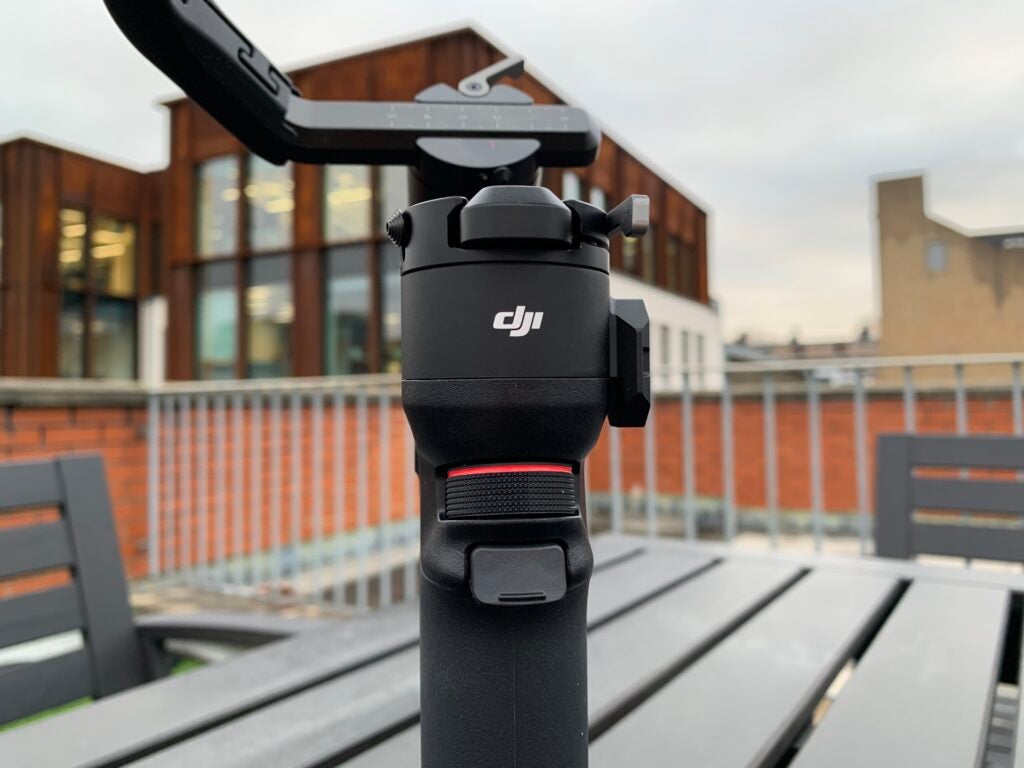
Likewise, there’s also a large front dial which can be used to access a range of features depending on your camera, including focus, optical and digital zoom, ISO, aperture and gimbal movements. The only options that seemed to work with my camera were the roll, pan and tilt movements of the gimbal, though this may have been a compatibility issue as I know the zoom feature (to name one) is only supported on certain Sony cameras.
While the lack of camera functions was a bit annoying, all of the gimbal features worked perfectly, including the three main stabilisation modes – PF, PTF and FPV.
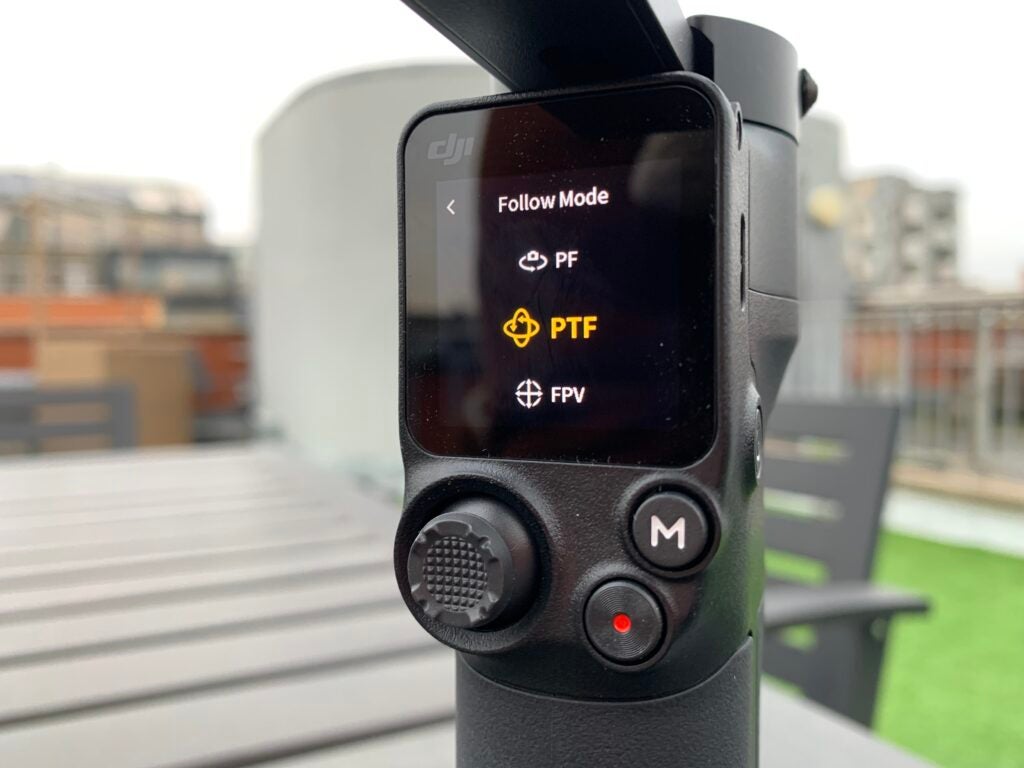
PF (Pan Follow) mode limits the gimbal’s movements to the pan axis and is best for left and right movements. This also happens to be the mode I found easiest to control. PTF (Pan and Tilt Follow) mode reserves movement for the pan and tilt axis and is best used to shoot diagonally, while FPV (Pan, Tilt and Roll Follow) allow all three axes to move and is designed for flipping shots. I found this to be the mode that offered the most freedom of movement but was also the most tricky to control.
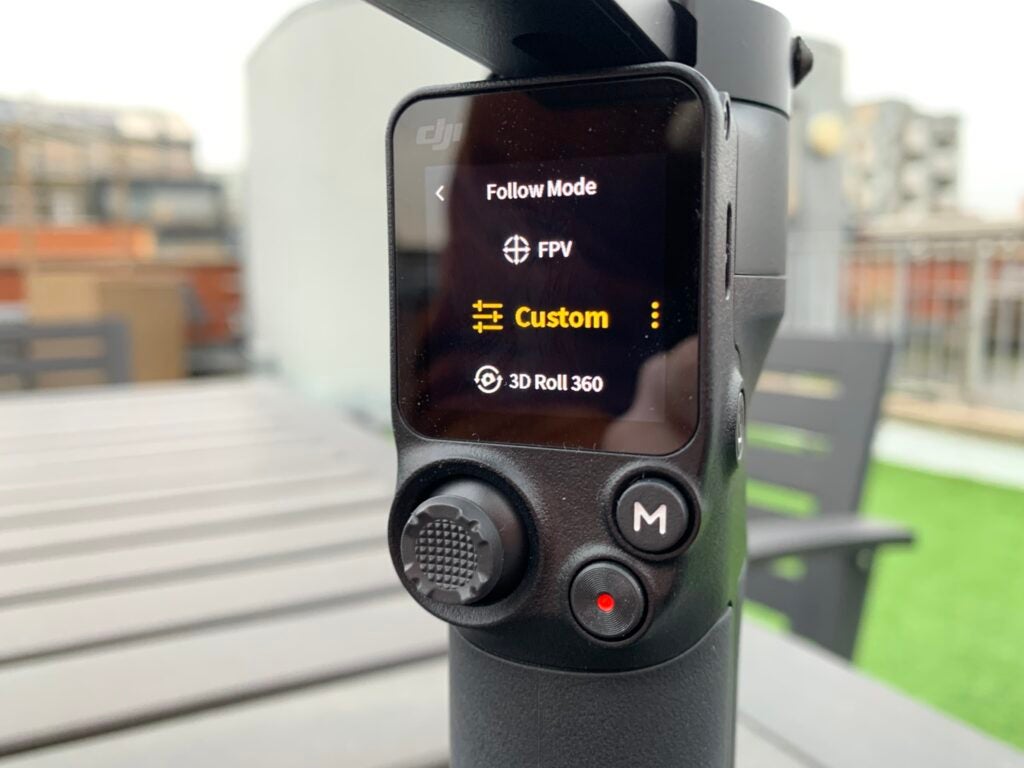
You can set custom modes to follow any axis of your choice, but my personal favourite feature was 3D Roll 360. This mode allows you to hold the grip parallel to the ground and use the joystick to rotate the camera 360 degrees resulting in a trippy time tunnel effect. The spinning motion is incredibly smooth and this isn’t an effect you can capture anywhere near as easily without a gimbal.
Finally, there’s the Ronin app, which introduces features like panorama, timelapse, track recording and the ability to control the gimbal using a PS4 or Xbox controller. I particularly liked how precise the panorama mode was and I can see track recording being indispensable for planning out shots in instances where you need the camera to get from point A to point B.
Handling and performance
- The gimbal produces smooth footage at a variety of speeds.
- There are multiple ways to control the movements of the gimbal
- The battery drains faster than expected
The DJI RS 3 Mini leverages DJI’s 3rd generation stabilisation algorithm, allowing it to produce smooth footage in a wide variety of situations. I found the gimbal did a fantastic job of following my arm movements at a variety of speeds and footage captured with the device was very stable.
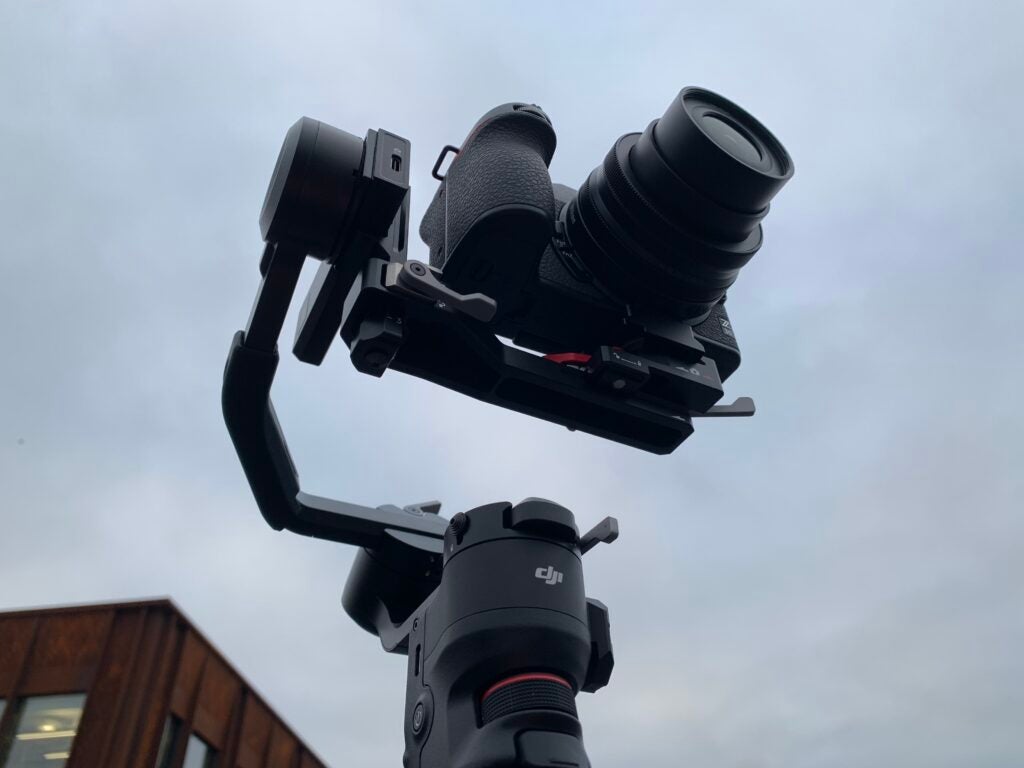
You can also adjust the speed manually by choosing between slow, medium, fast and custom, which ranges from 5-100 in increments of 5. I found the slow setting felt a bit too sluggish and fast was the toughest to control. Medium offered a sweet spot between the two, making it my favourite pace to film at.
The gimbal’s auto-tune feature determines the stiffness of the gimbal, but you also have the option to adjust any of the three axes manually using the touchscreen. Sport Mode, meanwhile, pushes both to the extreme, offering higher sensitivity and speed when activated.
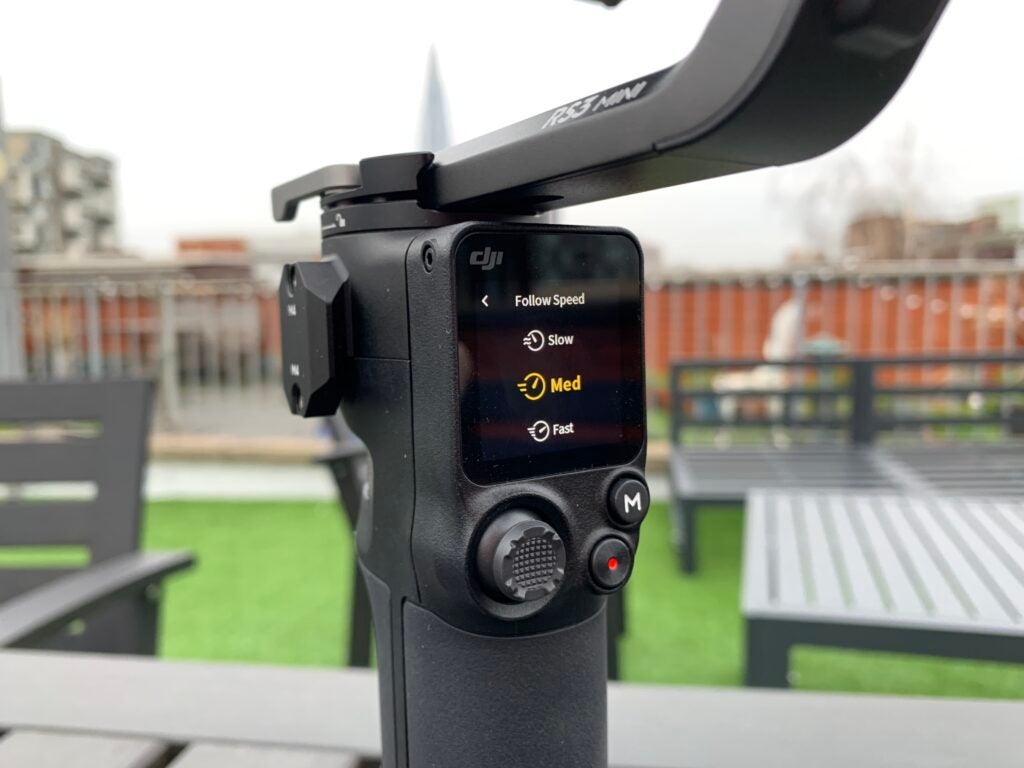
If you struggle to move the gimbal at certain angles or want to pan while the device is perched on a table, there’s also the joystick. This allows you to move the camera without just one finger and there’s also the option to adjust speed and smoothness with this method.
Finally, there’s the push mode, which allows you to physically move the camera to point in any direction when activated.
I found the trigger on the back of the gimbal to be very useful for bringing the camera back to its original position. Pressing the trigger twice recentres the camera, while hitting it three times flips the camera into selfie mode, essentially allowing vloggers to use the gimbal as a stabilising alternative to a selfie stick.
The only thing I’d note in this instance is that flipping your camera’s screen out will probably throw the gimbal off balance, so you’ll need to rebalance the camera if you want to see yourself as you vlog.
The last thing worth noting is battery life. The battery charges quickly but I also found it depleted very fast – this is despite DJI’s 10-hour battery claims. I monitored the battery for a number of hours and found it typically lost about 10% every 30 minutes, which would work out closer to 5 hours in total.
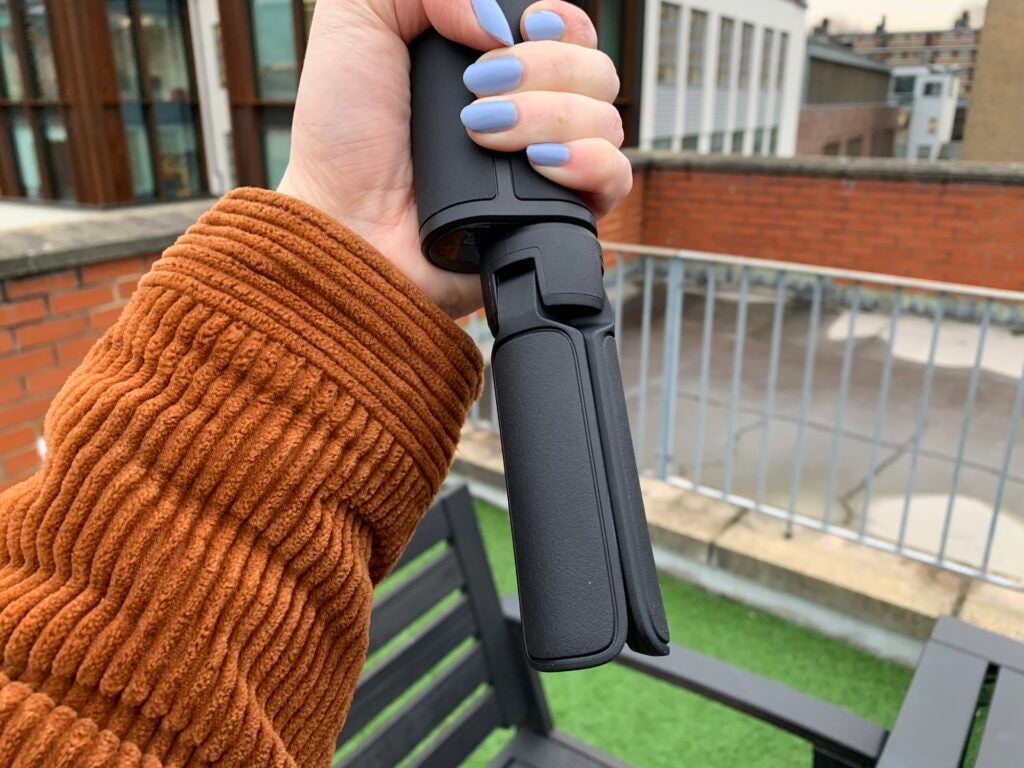
I can’t imagine many users would need to take the gimbal out for more than five hours at a time. After all, the Mini is marketed toward content creators over filmmakers recording for days at a time. However, you might find the gimbal will need to be left to charge between uses.
The RS 3 and the RS 3 Pro have a slightly longer 12-hour battery life, but we haven’t tested these models ourselves so we can’t say how accurate that number is with real-world use.
Latest deals
Should you buy it?
You want a compact but powerful gimbal: The RS 3 Mini might be small but it produces incredibly smooth footage and has plenty of tricks up its sleeve.
You want to shoot for hours on end: If you want to go days without charging your gimbal, you’ll be better opting for one with a longer battery life.
Final Thoughts
The DJI RS 3 Mini offers a more lightweight and travel-friendly alternative to its larger siblings, the RS 3 and the RS 3 Pro.
The gimbal produces smooth, stable video and is packed with useful features, from the selfie mode to track recording and the more creative 3D Roll 360 time tunnel mode. Setting the speed, stiffness and axes is easy using the bright touchscreen and you can start recording directly from the grip.
I wish I’d been able to experiment with more of the camera shortcuts and the short battery life was disappointing, but neither of these drawbacks would put me off recommending this gimbal to anyone looking for a compact and versatile stabiliser for small mirrorless cameras.
That said, if you’re looking to record smooth videos from your smartphone, make sure to check out our reviews of the DJI OM 5 and the Zhiyun Smooth Q4.
How we test
We test gimbals thoroughly, filming in a variety of conditions to give us the best possible test results.
Tested the gimbal in different environments
Experimented with all of the main features
Monitored the battery to determine how long it would last
FAQs
No, the RS 3 Mini is designed to be used alongside mirrorless cameras.
The gimbal has a claimed battery life of 10 hours, but we found it drained power faster than this.
Yes, it does. You can access additional features, like panorama and timelapse, through the DJI Ronin app.
Jargon buster
Bluetooth
Bluetooth – named after 10th-century Danish king Harald Bluetooth who united Denmark’s tribes into a single kingdom – is a method of wireless transmission that allows for the exchange of data between devices over short distances.
Verdict
The DJI RS 3 Mini is a powerful gimbal for stabilising small mirrorless cameras. The battery life is a bit disappointing, but there are plenty of features to play around with and it’s more compact and affordable than the other gimbals in its series.
Pros
- Video is smooth and stable
- More compact and lightweight than other gimbals
- Touchscreen makes it easy to move between different modes and speeds
Cons
- Shorter battery life than expected
- Not all shortcuts are compatible with all cameras
Availability
- UKRRP: £339
- USARRP: $369
-
Small, lightweight designThe DJI RS 3 Mini weighs 795g and measures 180 × 159 × 296mm unfolded -
Designed for mirrorless camerasCan support cameras and lens of up to 2kg -
360-degree rotationWith the pan axis -
DJI Ronin appWith additional features like panorama and timelapse
Introduction
If you’re in need of a new camera stabiliser but baulk at the idea of lugging around a large gimbal, the DJI RS 3 Mini could be right up your alley.
The RS 3 Mini marks the third instalment in DJI’s RS 3 line, sitting just below the RS 3 and the RS 3 Pro, both physically and in terms of its specs.
The gimbal is part of DJI’s goal to bring professional-grade tech to content creators and can be paired with a wide array of mirrorless cameras.
Keep reading to find out more about DJI’s latest (and smallest) RS gimbal.
Design
- Setting up and balancing the gimbal is difficult the first time
- There’s a small touchscreen, along with some physical controls
- The gimbal is small and lightweight for a mirrorless camera gimbal but it’s still quite heavy
The DJI RS 3 Mini comes with several items in the box which need to be assembled before you can get started. This includes the tripod extension, the mounting plate, a screw to attach the plate and the gimbal itself.
If you’re familiar with building Ikea furniture, you should be able to figure out what goes where by following the wordless diagrams in the manual.

Once that’s done, the next step is balancing the gimbal. This is the part I found the most difficult the first time I mounted a camera, as there are several locks and levers that need to be pushed in a specific order to balance it correctly.
I do think this is something that likely gets easier with practice, as DJI requires its users to rebalance the gimbal every time they attach a new camera. The company also walks you through the process on its DJI Tutorials YouTube channel, so you can always head over there if you forget which lever corresponds to which axis.

The RS 3 Mini itself has a simple black design with grey and red levers and a rubberised grip where the rechargeable battery lives.
Most of the controls can be found on the 1.4-inch colour touchscreen positioned above the grip, but there’s also a small array of physical buttons on the gimbal. These include a power button, a record button and an M button, as well as a trigger and a dial on the other side of the grip.

The gimbal also comes with a USB-C port for charging and a NATO port for attaching additional DJI accessories.
From its name, you might assume the RS 3 Mini would be small and lightweight – and it is compared to the other gimbals in its series. The Mini measures 180 × 159 × 296mm unfolded and weighs 795g. For comparison, the regular RS 3 measures 364 × 187 × 170mm and weighs 1.3kg and the RS 3 Pro is even bigger at 415 × 218 × 195mm and 1.5kg.
Despite its more compact size, the RS 3 Mini can handle up to 2kg of camera weight and has the added benefit of easily fitting in a tote bag or small backpack to take on the go.

While not nearly as heavy as the other gimbals in the series, the Mini isn’t exactly feather-light either. It’s a good job the device is designed to keep cameras stable, as otherwise, I think I would have captured a lot of shaky footage in my local park after waving it above my head for an hour. I didn’t even mount a particularly chunky camera and lens, opting to pair the gimbal with the lightweight Nikon Z30.
Regardless, that doesn’t change the fact that this is one of the most lightweight and travel-friendly mirrorless camera gimbals you’ll find, at least in DJI’s current line-up.
Features and companion app
- I had trouble getting some of the camera functions to work
- There are three main stabilisation modes, along with a custom mode and a fun 360-degree time tunnel feature
- Users can access more features in the Ronin app
According to DJI, the RS 3 Mini is compatible with most mainstream mirrorless cameras. Not only can you mount the camera for more stable video, but you can also use Bluetooth to control the shutter and access other features.
While I found the record button worked well, I couldn’t seem to get the camera to autofocus when I held the button down halfway or to snap a photo when I held the button for longer.

Likewise, there’s also a large front dial which can be used to access a range of features depending on your camera, including focus, optical and digital zoom, ISO, aperture and gimbal movements. The only options that seemed to work with my camera were the roll, pan and tilt movements of the gimbal, though this may have been a compatibility issue as I know the zoom feature (to name one) is only supported on certain Sony cameras.
While the lack of camera functions was a bit annoying, all of the gimbal features worked perfectly, including the three main stabilisation modes – PF, PTF and FPV.

PF (Pan Follow) mode limits the gimbal’s movements to the pan axis and is best for left and right movements. This also happens to be the mode I found easiest to control. PTF (Pan and Tilt Follow) mode reserves movement for the pan and tilt axis and is best used to shoot diagonally, while FPV (Pan, Tilt and Roll Follow) allow all three axes to move and is designed for flipping shots. I found this to be the mode that offered the most freedom of movement but was also the most tricky to control.

You can set custom modes to follow any axis of your choice, but my personal favourite feature was 3D Roll 360. This mode allows you to hold the grip parallel to the ground and use the joystick to rotate the camera 360 degrees resulting in a trippy time tunnel effect. The spinning motion is incredibly smooth and this isn’t an effect you can capture anywhere near as easily without a gimbal.
Finally, there’s the Ronin app, which introduces features like panorama, timelapse, track recording and the ability to control the gimbal using a PS4 or Xbox controller. I particularly liked how precise the panorama mode was and I can see track recording being indispensable for planning out shots in instances where you need the camera to get from point A to point B.
Handling and performance
- The gimbal produces smooth footage at a variety of speeds.
- There are multiple ways to control the movements of the gimbal
- The battery drains faster than expected
The DJI RS 3 Mini leverages DJI’s 3rd generation stabilisation algorithm, allowing it to produce smooth footage in a wide variety of situations. I found the gimbal did a fantastic job of following my arm movements at a variety of speeds and footage captured with the device was very stable.

You can also adjust the speed manually by choosing between slow, medium, fast and custom, which ranges from 5-100 in increments of 5. I found the slow setting felt a bit too sluggish and fast was the toughest to control. Medium offered a sweet spot between the two, making it my favourite pace to film at.
The gimbal’s auto-tune feature determines the stiffness of the gimbal, but you also have the option to adjust any of the three axes manually using the touchscreen. Sport Mode, meanwhile, pushes both to the extreme, offering higher sensitivity and speed when activated.

If you struggle to move the gimbal at certain angles or want to pan while the device is perched on a table, there’s also the joystick. This allows you to move the camera without just one finger and there’s also the option to adjust speed and smoothness with this method.
Finally, there’s the push mode, which allows you to physically move the camera to point in any direction when activated.
I found the trigger on the back of the gimbal to be very useful for bringing the camera back to its original position. Pressing the trigger twice recentres the camera, while hitting it three times flips the camera into selfie mode, essentially allowing vloggers to use the gimbal as a stabilising alternative to a selfie stick.
The only thing I’d note in this instance is that flipping your camera’s screen out will probably throw the gimbal off balance, so you’ll need to rebalance the camera if you want to see yourself as you vlog.
The last thing worth noting is battery life. The battery charges quickly but I also found it depleted very fast – this is despite DJI’s 10-hour battery claims. I monitored the battery for a number of hours and found it typically lost about 10% every 30 minutes, which would work out closer to 5 hours in total.

I can’t imagine many users would need to take the gimbal out for more than five hours at a time. After all, the Mini is marketed toward content creators over filmmakers recording for days at a time. However, you might find the gimbal will need to be left to charge between uses.
The RS 3 and the RS 3 Pro have a slightly longer 12-hour battery life, but we haven’t tested these models ourselves so we can’t say how accurate that number is with real-world use.
Latest deals
Should you buy it?
You want a compact but powerful gimbal: The RS 3 Mini might be small but it produces incredibly smooth footage and has plenty of tricks up its sleeve.
You want to shoot for hours on end: If you want to go days without charging your gimbal, you’ll be better opting for one with a longer battery life.
Final Thoughts
The DJI RS 3 Mini offers a more lightweight and travel-friendly alternative to its larger siblings, the RS 3 and the RS 3 Pro.
The gimbal produces smooth, stable video and is packed with useful features, from the selfie mode to track recording and the more creative 3D Roll 360 time tunnel mode. Setting the speed, stiffness and axes is easy using the bright touchscreen and you can start recording directly from the grip.
I wish I’d been able to experiment with more of the camera shortcuts and the short battery life was disappointing, but neither of these drawbacks would put me off recommending this gimbal to anyone looking for a compact and versatile stabiliser for small mirrorless cameras.
That said, if you’re looking to record smooth videos from your smartphone, make sure to check out our reviews of the DJI OM 5 and the Zhiyun Smooth Q4.
How we test
We test gimbals thoroughly, filming in a variety of conditions to give us the best possible test results.
Tested the gimbal in different environments
Experimented with all of the main features
Monitored the battery to determine how long it would last
FAQs
No, the RS 3 Mini is designed to be used alongside mirrorless cameras.
The gimbal has a claimed battery life of 10 hours, but we found it drained power faster than this.
Yes, it does. You can access additional features, like panorama and timelapse, through the DJI Ronin app.
Jargon buster
Bluetooth
Bluetooth – named after 10th-century Danish king Harald Bluetooth who united Denmark’s tribes into a single kingdom – is a method of wireless transmission that allows for the exchange of data between devices over short distances.


















